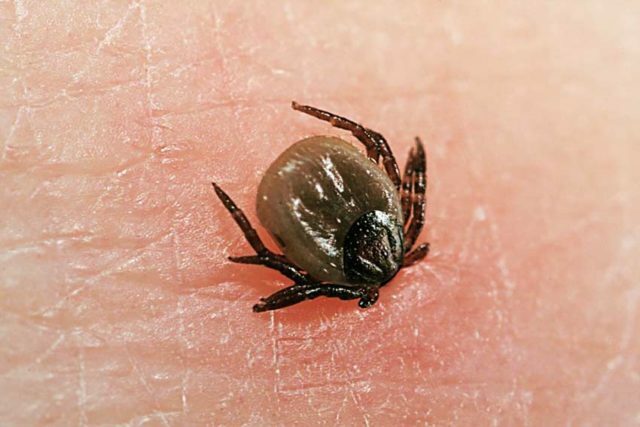
Contents of the page
- 1 The bite of a tick in a person can cause a difficult curable and dangerous disease - Lyme borreliosis
- 2 What does the tick tick look like in a person?
- 3 The most common symptoms after a bite
- 4 Possible consequences of a bite
- 5 Fever
- 6 Favorable prognosis
- 7 Adverse forecast
- 8 First aid
- 9 What tablets can help with tick bite?
- 10 Where can I get help?
- 11 Prevention or how to protect yourself? Ticks in the house: what to do?
Blood-sucking tongs are carriers of numerous infections and belong to a class of particularly dangerous ones. The most serious infections carried by ticks are encephalitis and borreliosis.
Ticks most often feed on fungi, plant residues or smaller arthropods. A lot of risk for a person is borne by mites and parasites. Their food consists of the blood of animals or people.
A tick bite in a person can cause a difficult curable and dangerous disease - Lyme borreliosis
This disease for a short time affects the nervous system, the musculoskeletal system and the heart. This tick-borne disease can be cured due to prolonged therapy, but even treatment does not exclude the death of a person or the appearance of one of the degrees of disability.
 The mite is able to absorb a large amount of blood, which can exceed the arthropod's own weight by more than 100 times. The tick's bite in a person does not cause painful sensations. So, notice the presence of bloodsucking on the skin can not immediately, because the size of the pest is no more than a match head. Blood-fed tick can reach impressive sizes - up to 1.5 cm in diameter.
The mite is able to absorb a large amount of blood, which can exceed the arthropod's own weight by more than 100 times. The tick's bite in a person does not cause painful sensations. So, notice the presence of bloodsucking on the skin can not immediately, because the size of the pest is no more than a match head. Blood-fed tick can reach impressive sizes - up to 1.5 cm in diameter.
Infectious agents are located on the proboscis and paws of a tick. The arthropod can easily cling to the human skin thanks to microscopic claws and suckers on the feet. The most favorite areas of the human body in ticks are those places, the blood supply in which is especially intense. These include: 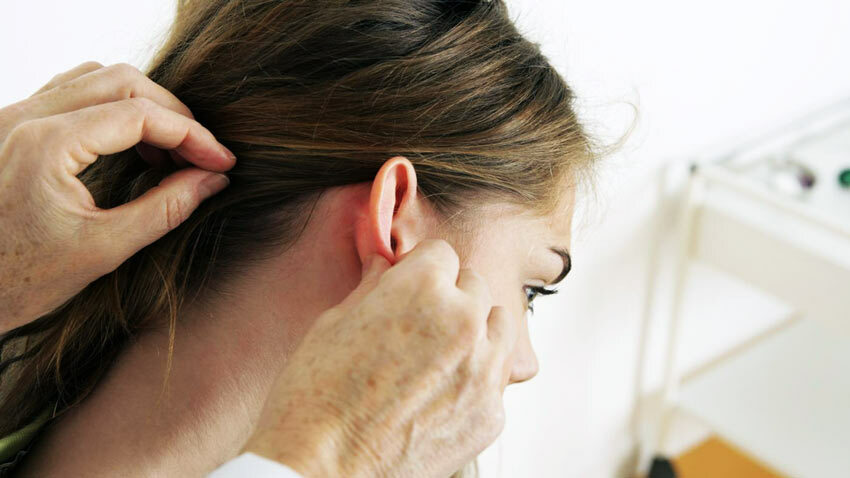
- axillary cavities;
- groin area;
- popliteal areas;
- neck and area behind the auricles;
- head, especially its hairy part.
These places are convenient for arthropods due to the fact that they can hide for a while and get drunk of blood, remaining unnoticed by a person. That is why, after a rest on the nature it is worth to make a careful survey of these areas on your own and to examine relatives for finding mites.
What does a person's tick bite look like?
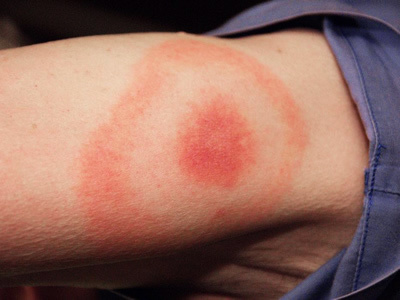 A person's tick bite can often manifest itself in different ways. What does the tick bite look like in its usual manifestation? The most innocuous manifestation is a slight reddening around the place where an arthropod or complete absence of traces on the skin was found, except for a small hole in the place where the proboscis was.
A person's tick bite can often manifest itself in different ways. What does the tick bite look like in its usual manifestation? The most innocuous manifestation is a slight reddening around the place where an arthropod or complete absence of traces on the skin was found, except for a small hole in the place where the proboscis was.
The bite site may be slightly inflamed. There may also be an allergic reaction, triggered by saliva and the existing microtrauma of the skin. The bite of a tick in a person can lead to more dangerous reactions on the skin.
It is easy enough to recognize the tick bite in a person infected with borreliosis. The place around the bite resembles erythema. The spot may increase in diameter to an average of 15-20 cm. Sometimes a red spot can reach 60 cm, covering not only the site of the bite, but also a significant part of the body. The stain in this case can have any shape. A characteristic sign of the bite of a tick that has undergone borreliosis is the appearance of a distinct bloody rim around the spot on the skin. At the same time, the entire central part of the spot becomes whitish or unhealthy, cyanotic.
The most common symptoms after a bite
 The tick bite in a person does not cause pain. In the saliva of the arthropod, there are elements that anesthetize the process of piercing the skin with a proboscis, and a person may not notice the presence of bloodsucking on the body for a very long period.
The tick bite in a person does not cause pain. In the saliva of the arthropod, there are elements that anesthetize the process of piercing the skin with a proboscis, and a person may not notice the presence of bloodsucking on the body for a very long period.
The first symptoms after a tick bite may appear 2-4 hours after the bite. They include:
- headache;
- weakness;
- photophobia;
- drowsiness;
- chills;
- aches in the joints;
- pain in the muscles.
The severity of the symptoms depends on how many mites have simultaneously attached to the body. Also an important factor is the age of a person. For example, the most vivid symptoms are in the elderly and children. People suffering from chronic diseases, immunodeficiency, or allergies can also feel a significant soreness of the symptoms of tick bite.
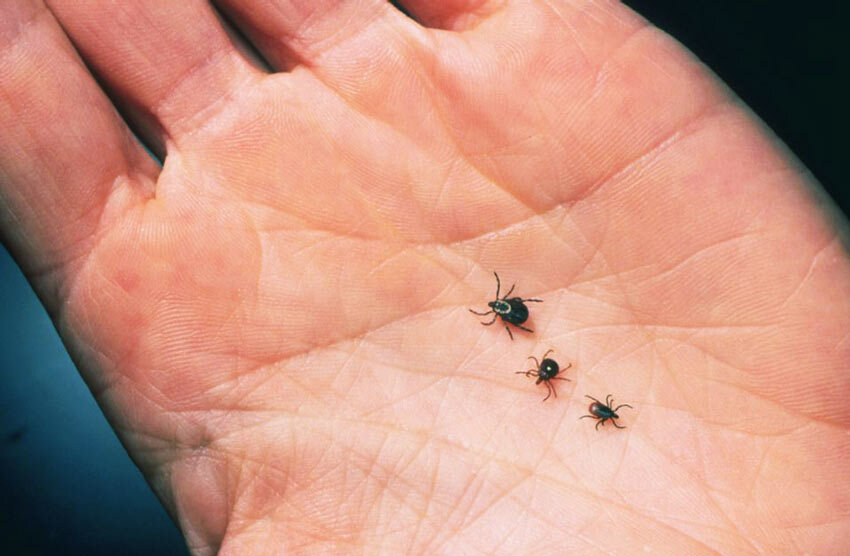 The tick bite in a person has also characteristic first signs, among which:
The tick bite in a person has also characteristic first signs, among which:
- the appearance of a rash accompanied by itching;
- enlarged lymph nodes;
- pressure reduction;
- tachycardia;
- hyperthermia( about 37-380C).
Overly sensitive people can feel such signs of a tick bite as:
- nausea;
- vomiting and indigestion;
- severe headache;
- dizziness;
- breathing with wheezing;
- hallucinations.
Found on the human body tick, almost in each of the cases has time to safely suck on the skin. On the skin, you can find two types of mite: the imago and the nymph. Imago is a species that has 4 pairs of legs and is an adult specimen of an arthropod. The nymph is one of the larval stages and has 3 pairs of legs.

A complex and rather rare symptom arising after a tick bite in a person is Quincke's edema. This symptom appears in people prone to allergic reactions. If this symptom occurs, a person may have swelling of the lips and eyelids, muscle aches and cramps, as well as shortness of breath. These symptoms are very dangerous. To eliminate them, you must call an ambulance or call the hospital immediately. Emergency relieve severe swelling with antihistamines or with an intramuscular injection of Prednisolone in a dose of 60 mg.
Possible consequences of a bite
 In most cases, all have become accustomed to tick bites having a favorable outcome for a person. This insect is a real threat not only for human health, but also for his life. Most often the consequences after a tick bite are manifested in the form of lesions of any body system:
In most cases, all have become accustomed to tick bites having a favorable outcome for a person. This insect is a real threat not only for human health, but also for his life. Most often the consequences after a tick bite are manifested in the form of lesions of any body system:
- nervous system disorder - encephalitis;
- epilepsy;
- hyperkinesis;
- paralysis;
- headache;
- arthritis;
- disturbance of the circulatory system( arrhythmia);
- pulmonary hemorrhage( pneumonia);
- malfunctioning liver;
- indigestion.
A tick bite in a person can present a surprise not only as a violation of the body's functions, mites are frequent carriers of various microbial and viral diseases. Among them we can distinguish: typhus fever, spotted fever, other rare types of fevers.
Fever
 Fever attacks are one of the possible consequences that appear after a tick bite in a person. The first alarming bells can appear only after a week in the form of an increase in body temperature. This can be a fairly innocuous allergic reaction of the body to the saliva of an insect or the first sign of a developing infection.
Fever attacks are one of the possible consequences that appear after a tick bite in a person. The first alarming bells can appear only after a week in the form of an increase in body temperature. This can be a fairly innocuous allergic reaction of the body to the saliva of an insect or the first sign of a developing infection.
- Encephalitis is a typical reaction to a person's tick bite, characterized by a recurrent reaction. In a few days, the patient can significantly increase body temperature, which during the next two days begins to gradually return to normal. Repeated fever may occur in a week. The main danger is the absolute similarity of encephalitis with the symptoms of influenza. Often the victim does not have time to pay attention to instantly developing symptoms, while the central nervous system is already undergoing negative changes.
-
 Borreliosis - resembles encephalitis by its features, but is characterized by a number of additional symptoms in the form of chills, muscle weakness, dizziness. If the infection is not eliminated on time through a course of antibiotics, then the disease quickly passes into a chronic form, which jeopardizes a person's life. As the main symptom in a person may appear ring-shaped swelling, reminiscent of the bites of a large insect.
Borreliosis - resembles encephalitis by its features, but is characterized by a number of additional symptoms in the form of chills, muscle weakness, dizziness. If the infection is not eliminated on time through a course of antibiotics, then the disease quickly passes into a chronic form, which jeopardizes a person's life. As the main symptom in a person may appear ring-shaped swelling, reminiscent of the bites of a large insect. - Ehrlichiosis - manifests itself at least a week after a tick bite in a person in the form of a fever of a moderate type and lasts for 20 days. The disease is accompanied by joint pains and chills. Requires the supervision of a doctor to avoid possible complications. Otherwise, after a while, the victim develops stiff neck muscles, accompanied by nausea, dizziness and poor health.
- Anamlasmosis - manifests itself as hyperthermia( body overheating) only two weeks after the tick bite
Favorable prognosis of
 With the timely application of qualified care and the elimination of the progression of encephalitis, the patient can expect a full recovery, which will not affect the quality of life in the future.
With the timely application of qualified care and the elimination of the progression of encephalitis, the patient can expect a full recovery, which will not affect the quality of life in the future.
- chronic weakness, holding up to two to three months with further recovery;
- chronic weakness with salivation for up to six months without significant deterioration in health status;
- is a complex form of re-salting with a rehabilitation period of up to two years, but later with full recovery of mobility and performance.
Unfavorable prognosis of
The bite of encephalitic tick is the focus of dangerous natural infectious diseases, capable of harming a person in 7 out of 10 cases by damaging the nervous system. When the condition is neglected, encephalitis significantly affects the quality of human life, which in the future gives rise to the definition of disability.
- Deterioration of quality of life, manifested in the form of dysfunction of certain limbs. Symptom does not progress, but no improvement;
- Dysfunction of motor functions with a constant progression of symptoms( headache, fever, fever, chronic fatigue).
Disability in case of an unfavorable outcome is determined after the examination of the medical commission, which on the basis of the diagnosis and the available analyzes make the final verdict and issue a single document confirming the incapacity of the victim.
-
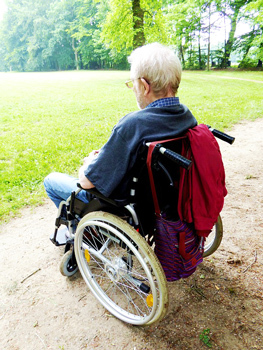 1 group of disability - severe impairment of motor functions, inability to move independently without the help of outsiders, loss of self-control and self-control, a sharp decline in mental abilities, disorientation, seizures of epilepsy.
1 group of disability - severe impairment of motor functions, inability to move independently without the help of outsiders, loss of self-control and self-control, a sharp decline in mental abilities, disorientation, seizures of epilepsy. - 2 group disability - a sharp decline in performance, a restriction in physical capabilities, a rare epileptic seizures in conjunction with chronic body fatigue.
- 3 group of disability - an insignificant decrease in physical activity, in rare cases possible insignificant seizures of epilepsy, loss of professional skills, distraction of attention.
If you receive a disability, the victim for the rest of his life is under the supervision of specialists. This allows to carry out a number of necessary measures to alleviate the patient's condition, and to prevent the progression of the disease.
First aid
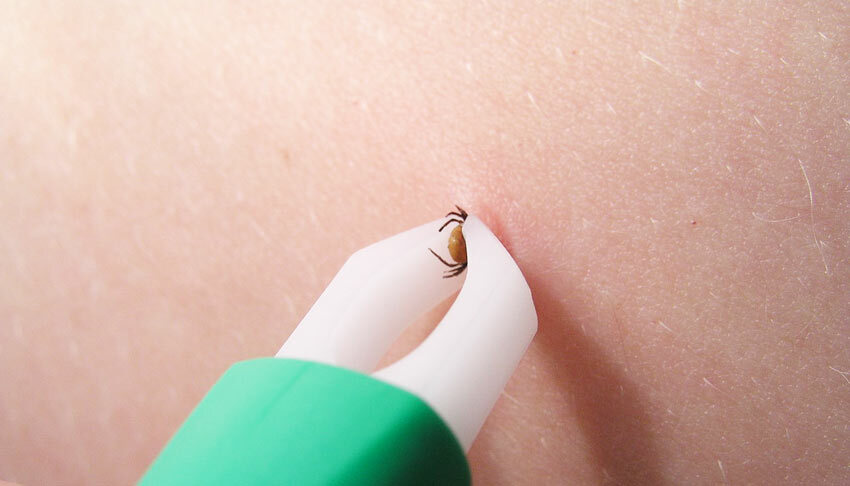 Having discovered a parasite on its body, it is necessary to urgently provide first aid, namely, to remove the tick from its body. Ideally, this should be done by a medical professional, who, equipped with an antiseptic and tweezers, quickly and without pain will solve your problem.
Having discovered a parasite on its body, it is necessary to urgently provide first aid, namely, to remove the tick from its body. Ideally, this should be done by a medical professional, who, equipped with an antiseptic and tweezers, quickly and without pain will solve your problem.
In hospital, a whole series of preventive measures are provided to the patient, contributing to the fact that complications after an insect bite will not follow. So, in the hospital, the tick is immediately given for examination to the laboratory for the detection of dangerous infectious diseases. The tick of a tick is immediately treated with hydrogen peroxide or with medical alcohol. On the same day, a person is prescribed a three-day course of immunoglobulins. These drugs can stop the spreading infection and prevent it from spreading further down the blood vessels.
 If you are away from the nearest hospital, then the parasite can be removed and yourself. This is done with olive oil. Several of its drops should be dripped straight to the place where the parasite is located. Within 5-10 minutes the mite creeps out itself, but if this does not happen, then the insect can be removed with tweezers, gently wringing it counter-clockwise. It must be ensured that the head of the parasite does not remain inside. You can also pierce the insect's abdomen with a heated needle. The principle of getting rid of the tick remains the same as in the first case.
If you are away from the nearest hospital, then the parasite can be removed and yourself. This is done with olive oil. Several of its drops should be dripped straight to the place where the parasite is located. Within 5-10 minutes the mite creeps out itself, but if this does not happen, then the insect can be removed with tweezers, gently wringing it counter-clockwise. It must be ensured that the head of the parasite does not remain inside. You can also pierce the insect's abdomen with a heated needle. The principle of getting rid of the tick remains the same as in the first case.
The place of bite is processed by everything that you can find at hand: peroxide, alcohol, cologne, vodka. Remove from the skin of the mite should not be discarded. Gently fold in a sealed bag or matchbox and give for examination in the clinic. So, you will surely know if you were worth worrying about or resorting to any treatment in the future.
What tablets can help with tick bite?
If the infestation of the tick is confirmed and you need urgent medical treatment to stop the development of encephalitis. The following drugs are prescribed for treatment:
-
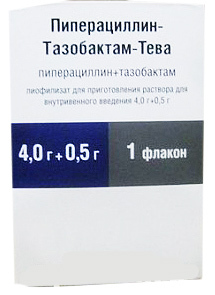 Piperacilin is a drug used in the presence of hypersensitivity to other drugs and during pregnancy. It is administered intravenously several times a day. The use of the drug can eliminate the effects of an insect bite.
Piperacilin is a drug used in the presence of hypersensitivity to other drugs and during pregnancy. It is administered intravenously several times a day. The use of the drug can eliminate the effects of an insect bite. - Levomycitin - used 3-4 times a day. Often appointed in combination with other drugs. The standard course of treatment is 10 days. The individual dose and method of administration is calculated for pregnant women and children with kidney and liver problems.
- Azlotsilin - a powerful tool that can completely destroy the existing virus in the body. The maximum dosage is no more than 8 grams per day. It is used in emergency cases, as it often provokes vomiting, nausea and cramps in the muscles.
- Polyuglyukin - the substance is administered intravenously under the guise of a dropper. It is used to cleanse blood and eliminate infection. The maximum allowable amount per day is assigned individually, but the standard dosage does not exceed 2.5 liters.
-
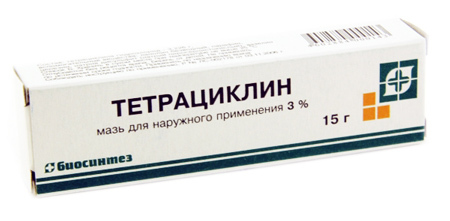 Tetracycline ointment - often used as an ointment. The substance is applied to the bite site every 6 hours. For convenience, you can buy a product in the form of tablets.
Tetracycline ointment - often used as an ointment. The substance is applied to the bite site every 6 hours. For convenience, you can buy a product in the form of tablets. - Prednisolone - is taken no more often than once a day. Designed to prevent the consequences of a tick bite. The substance has a weighty effect on the body's immune system, can cause sleep disturbances and digestive problems.
Where to go for help?
The doctor should be treated in several cases:
- A tick bite in a person caused symptoms of SARS: joint pain, fever, drowsiness, etc.
- There is no way to get the mite yourself.
- With self-removal of the tick from the skin, the proboscis remained in the skin.
 If self-removal of the tick from the skin was successful and later no traces of cyanotic or bard color were found on the skin, and the condition of the bitten person did not worsen, doctors should not be treated. So, it is necessary to monitor the body temperature throughout the week, also closely monitor the site of the bite and its healing.
If self-removal of the tick from the skin was successful and later no traces of cyanotic or bard color were found on the skin, and the condition of the bitten person did not worsen, doctors should not be treated. So, it is necessary to monitor the body temperature throughout the week, also closely monitor the site of the bite and its healing.
If the condition of the body after the bite of the blood-sucking tick has worsened( this can happen in the first 2-3 hours after the arthropod was on the skin), it is necessary immediately to call an ambulance or take the victim to the receiving room. After this, the injured will be examined by the surgeon and the first medical aid will be provided. It is possible for a person to be given a surrender of tests and treatment within the walls of the hospital.
Prevention or how to protect yourself?
 The tick is waiting for its prey on bushes, low-falling branches of trees or in dense grass near forest paths. Most often the mite does not rise higher than a meter from the ground. That is why, the mites first cling to the feet of a person, and later crawl upward on clothing or bare skin.
The tick is waiting for its prey on bushes, low-falling branches of trees or in dense grass near forest paths. Most often the mite does not rise higher than a meter from the ground. That is why, the mites first cling to the feet of a person, and later crawl upward on clothing or bare skin.
The first and most reliable means of safety is proper clothing. Not many people know that mites can not get to the skin through the tissue and never suck in to the body through the fabric covers. When choosing clothes for walking or relaxing in nature, it is necessary to observe 7 simple rules.
- Light clothing is very convenient in finding ticks. On light fabrics to find bloodsucking very easily.
- The top of clothing should be snug to the body. Sleeves should be long and have cuffs on their wrists.
- You must top your clothes in trousers.
- Do not wear shorts, even if they fit tightly to the foot.
- Trousers or sports pants should be tucked into socks or into high shoes.
- Take care of the headdress. Ideal options will be a cap or a panama.
- All clothing should be treated with acaricidal preparations.
 During the rest in the open area, you should not choose a halt near the trails. It is better to retreat into the thicket of the forest and rest there, since the majority of pests are localized precisely along paths where animals and people often walk.
During the rest in the open area, you should not choose a halt near the trails. It is better to retreat into the thicket of the forest and rest there, since the majority of pests are localized precisely along paths where animals and people often walk.
Ticks do not tolerate heat and live in wet shaded areas. Therefore, on a sunny glade, chosen for rest, the probability of being overtaken by a blood-sucking tick decreases to a considerable extent.
When choosing an overnight stay in nature in autumn and winter, it is worth knowing some of the nuances of the behavior of ticks. Hibernate mites in the dried grass and leaves. But they can get out of hibernation under the influence of sunlight. In such periods, mites can also attack their victim in order to satisfy hunger. Ticks in the house: what to do?
 Often ticks fall into the room on the clothes of the owners or on the animal's fur. Human habitation is not a comfortable place for the life and reproduction of the tick, but in spite of this, the bloodsucker can live in the house or apartment for several weeks and, in the presence of comfortable conditions, get on the skin of an animal or person.
Often ticks fall into the room on the clothes of the owners or on the animal's fur. Human habitation is not a comfortable place for the life and reproduction of the tick, but in spite of this, the bloodsucker can live in the house or apartment for several weeks and, in the presence of comfortable conditions, get on the skin of an animal or person.
It is impossible to treat living quarters from ticks with special means. Means against arthropods are very toxic and can lead to poisoning of the body. But if one or more ticks were still found in the room, they will have to struggle with them only on their own. So, for the safety of households, you need to do a thorough cleaning throughout the house, remove the carpets and several times vacuum the floors and soft furniture elements.
Frequent misconceptions of
There are a lot of misconceptions regarding the tick bite in a person. Moreover, very often these errors are operated by the doctors themselves, which indicates their lack of education. It is worth considering the most frequent myths that concern a blood-sucking tick. In the case of a bite, this will help to quickly navigate and not exacerbate the situation.
Myth # 1: The most effective method of extracting a tick is thread, machine oil or gasoline.
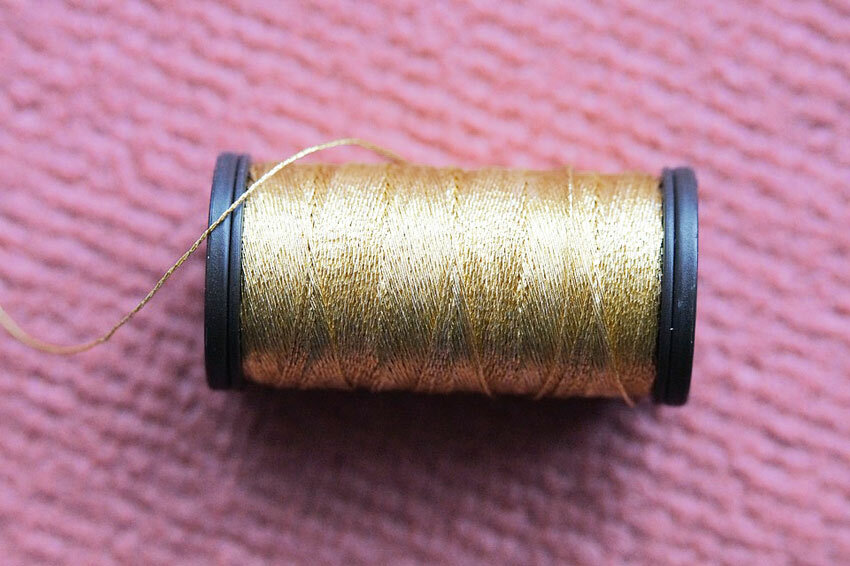 This myth has a bit of truth. Indeed, a thread tied around the proboscis can help if you perform the procedure of "twisting" neatly. Turns should be done very slowly and gradually, so that the proboscis of the insect does not remain inside and does not cause subsequent infection.
This myth has a bit of truth. Indeed, a thread tied around the proboscis can help if you perform the procedure of "twisting" neatly. Turns should be done very slowly and gradually, so that the proboscis of the insect does not remain inside and does not cause subsequent infection.
But these methods have their own disadvantages. Aggressive fluids, whether engine oil or gasoline can seriously damage the human skin, which is why their use must be excluded.
Myth # 2: If you remove the tick right after the bite, you can eliminate the risk of encephalitis infection.
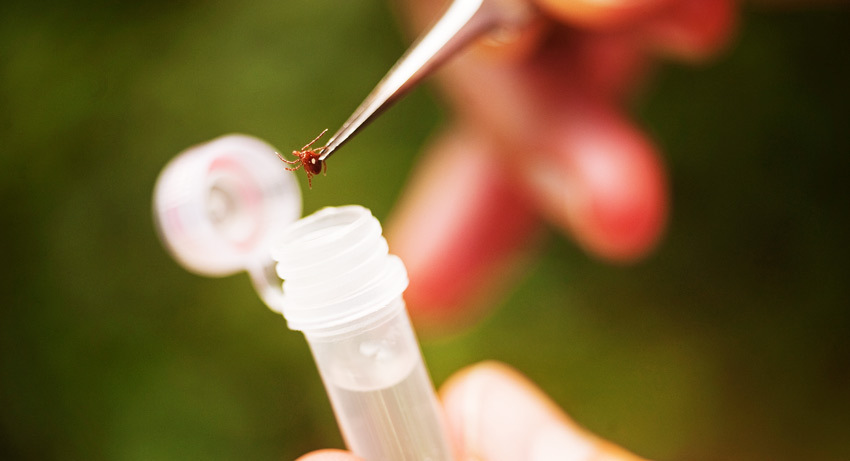 Tick-borne encephalitis is a virus that is contained in the saliva of the blood-sucking. It gets into the blood at the time of the bite. That is why, the time through which the tick will be removed does not matter, since encephalitis instantly infects a person. But there is one more dangerous disease, in which the speed of tick removal is very important - borreliosis. In this case, rapid removal of the tick can save a person's health.
Tick-borne encephalitis is a virus that is contained in the saliva of the blood-sucking. It gets into the blood at the time of the bite. That is why, the time through which the tick will be removed does not matter, since encephalitis instantly infects a person. But there is one more dangerous disease, in which the speed of tick removal is very important - borreliosis. In this case, rapid removal of the tick can save a person's health.
Myth # 3: If the bite of the tick changes color and turns red, then it means borreliosis or encephalitis.
Redness of a tick bite in a person does not indicate a 100% infection. Changing the color of the skin can talk about the sensitivity of the skin, allergic reaction or prolonged stay bloodsucking on the human body. If there is swelling or changes in the surface of the skin, you should immediately go to the hospital. In this case, the extracted mite should be stored in a sealed tube for its study to identify a hazard to human health.
Myth # 4: If the tested tick that bites a person has encephalitis, this is a 100% guarantee that the person is also infected.
 It is not always the presence of the encephalitis virus in the tick indicating that the person bitten by it will become ill. The disease may not develop if the body cope with the virus, which is observed in most cases. The most common thing to notice is the presence of the virus that the tick has carried, it is possible within the first month after the event. The site of a bite may change, a person may have headaches and a significant fever, fever.
It is not always the presence of the encephalitis virus in the tick indicating that the person bitten by it will become ill. The disease may not develop if the body cope with the virus, which is observed in most cases. The most common thing to notice is the presence of the virus that the tick has carried, it is possible within the first month after the event. The site of a bite may change, a person may have headaches and a significant fever, fever.
Myth # 5: After finding the tick, it is necessary to crush it with a knife or a solid object.
The consequences of an innocuous, at first glance, method of dealing with arthropods can be very unpleasant. If the tick is the carrier of the infection, then squeezing it, a person can get infected: the infection can get on the wounds or microcracks in the skin, as well as on the mucous membrane, after which the human body can be infected.



